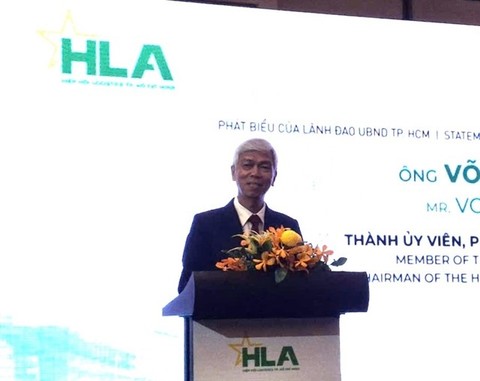
Võ Văn Hoan, deputy chairman of the People’s Committee, speaks at HCM City Logistics 2024 conference organised by the HCM City Logistics Association on Friday. — VNA/VNS Photo
HCM City is set to enhance its logistics sector to become a key logistics hub in Southeast Asia by 2030, leveraging global supply chain opportunities.
Speaking at the HCM City Logistics conference organised by the HCM City Logistics Association on Friday, Võ Văn Hoan, deputy chairman of the People’s Committee said the city aims to position itself as a key logistics service centre in global supply chains.
The city aims to develop logistics into a pioneering and sustainable economic sector, with a goal to become a logistics service hub not only for Asia but also on a global scale by 2045.
Logistics is one of Việt Nam’s rapidly expanding sectors, boasting an annual growth rate of 16 per cent, he said.
The city has recently unveiled a plan to enhance logistics infrastructure by improving port capacity and expanding warehousing.
Investment projects will be executed transparently and equitably, with support for private sector involvement through favourable tax policies and streamlined processes.
A priority is the transition to green logistics to reduce emissions and promote sustainability, which is vital for competitiveness and growth.
Projects incorporating Industry 4.0 technologies, digital transformations, and environmental protection will be prioritised.
The goal is to develop modern logistics infrastructure and improve connectivity in the southeastern region and the Southern Key Economic Zone.
Challenges
The global logistics sector is currently grappling with challenges such as economic uncertainty, geopolitical tensions, supply chain disruptions, and natural disasters, which have adversely affected Việt Nam's logistics industry.
Phạm Thanh Sơn, director of Tân Cảng Hiệp Phước Joint Stock Company, said that Việt Nam’s logistics industry must leverage more than its current advantages to thrive.
Việt Nam ranked 43rd in the Logistics Performance Index (LPI) in 2023.
The country’s logistics infrastructure investment has reached 5.7 per cent of GDP, the highest in Southeast Asia, contributing 4-5 per cent to national GDP and employing over one million people.
With around 9,600 registered logistics enterprises, accounting for 36.7 per cent of the national total, opportunities exist in areas like Hiệp Phước and Nhà Bè ports.
The upcoming Ring Road 3 is expected to enhance transport and reduce logistics costs.
However, public investment in infrastructure has only reached 22 per cent of planned disbursement, leaving unresolved traffic bottlenecks that hinder logistics development.
Sơn recommended improving infrastructure through accelerated road projects, railway connections, and developing waterway ports.
Vietnamese logistics firms, mostly small to medium-sized, need to optimise operations, embrace digital transformation, and invest in new technologies to enhance competitiveness.
The sector faces challenges from fragmented policies and limited infrastructure, yet the market, valued at around $40 billion in 2023, is projected to grow by 14-15 per cent by 2025, driven by free trade agreements and a favourable investment climate.
The global logistics market is expected to reach $21.91 trillion by 2033, growing at 9.35 per cent annually. — VNS